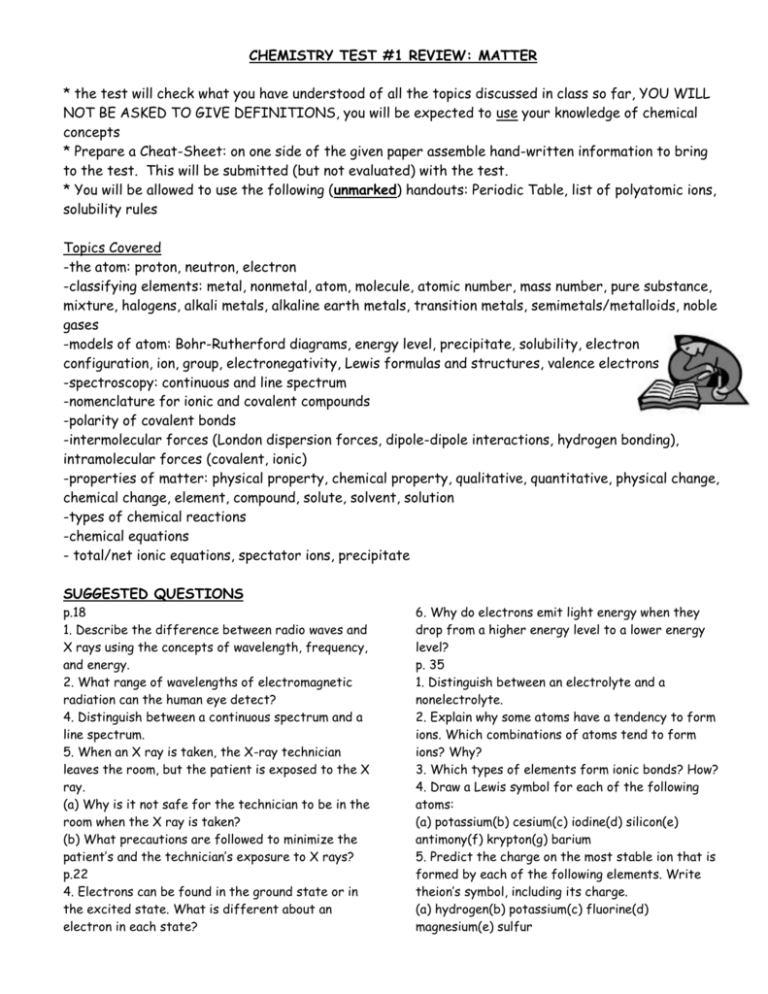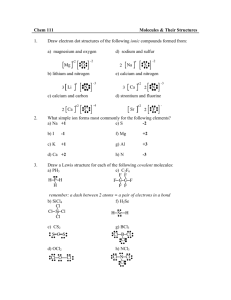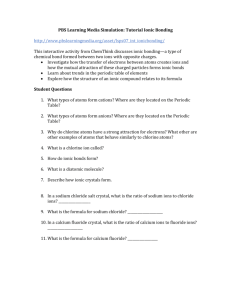matterTestReview
advertisement

CHEMISTRY TEST #1 REVIEW: MATTER * the test will check what you have understood of all the topics discussed in class so far, YOU WILL NOT BE ASKED TO GIVE DEFINITIONS, you will be expected to use your knowledge of chemical concepts * Prepare a Cheat-Sheet: on one side of the given paper assemble hand-written information to bring to the test. This will be submitted (but not evaluated) with the test. * You will be allowed to use the following (unmarked) handouts: Periodic Table, list of polyatomic ions, solubility rules Topics Covered -the atom: proton, neutron, electron -classifying elements: metal, nonmetal, atom, molecule, atomic number, mass number, pure substance, mixture, halogens, alkali metals, alkaline earth metals, transition metals, semimetals/metalloids, noble gases -models of atom: Bohr-Rutherford diagrams, energy level, precipitate, solubility, electron configuration, ion, group, electronegativity, Lewis formulas and structures, valence electrons -spectroscopy: continuous and line spectrum -nomenclature for ionic and covalent compounds -polarity of covalent bonds -intermolecular forces (London dispersion forces, dipole-dipole interactions, hydrogen bonding), intramolecular forces (covalent, ionic) -properties of matter: physical property, chemical property, qualitative, quantitative, physical change, chemical change, element, compound, solute, solvent, solution -types of chemical reactions -chemical equations - total/net ionic equations, spectator ions, precipitate SUGGESTED QUESTIONS p.18 1. Describe the difference between radio waves and X rays using the concepts of wavelength, frequency, and energy. 2. What range of wavelengths of electromagnetic radiation can the human eye detect? 4. Distinguish between a continuous spectrum and a line spectrum. 5. When an X ray is taken, the X-ray technician leaves the room, but the patient is exposed to the X ray. (a) Why is it not safe for the technician to be in the room when the X ray is taken? (b) What precautions are followed to minimize the patient’s and the technician’s exposure to X rays? p.22 4. Electrons can be found in the ground state or in the excited state. What is different about an electron in each state? 6. Why do electrons emit light energy when they drop from a higher energy level to a lower energy level? p. 35 1. Distinguish between an electrolyte and a nonelectrolyte. 2. Explain why some atoms have a tendency to form ions. Which combinations of atoms tend to form ions? Why? 3. Which types of elements form ionic bonds? How? 4. Draw a Lewis symbol for each of the following atoms: (a) potassium(b) cesium(c) iodine(d) silicon(e) antimony(f) krypton(g) barium 5. Predict the charge on the most stable ion that is formed by each of the following elements. Write theion’s symbol, including its charge. (a) hydrogen(b) potassium(c) fluorine(d) magnesium(e) sulfur 6. Draw Lewis symbols for the element ions in question 5. What similarity do you notice? State the rule that is being followed. 7. Using Lewis symbols and the octet rule, illustratehow each of the following pairs of atoms bond: (a) potassium and chlorine(b) magnesium and sulfur p.39 1. Draw Lewis symbols for the reaction between two bromine atoms. 2. Draw Lewis symbols for the reaction between one nitrogen atom and three hydrogen atoms. Draw the Lewis structure for the resulting ammonia molecule. 3. Draw Lewis symbols for the reaction between one carbon atom and four hydrogen atoms. Draw the Lewis structure for the resulting methane molecule. 4. Draw Lewis symbols for the reaction between one silicon atom and two oxygen atoms. Draw the Lewis structure for the resulting silicon dioxide molecule. p.45 1. Which of the following pairs of atoms form covalent bonds, and which form ionic bonds? How do you know? (a) sulfur and oxygen (b) sodium and iodine (c) bromine and bromine 2. Draw a Lewis structure for each of the following molecules: (a) F2 (b) H2 (c) O2 (d) H2S (e) CO2 3. Which of the molecules in question 2 are polar molecules? Which are nonpolar? 4. How are a covalent bond and an ionic bond different? How are they similar? 6. Identify the more polar bond in each of the following pairs. (a) H—F and H—Cl (b) N—O and C—O (c) S—H and O—H (d) P—Cl and S—Cl (e) C—H and N—H (f) S—O and P—O (g) C—N and N—N 8. (a) What is an intermolecular bond? (b) What type(s) of intermolecular forces of attraction may form between nonpolar molecules? What type(s) may form between polar molecules? Give reasons in both cases. 10. How do intermolecular bonds help to explain why the boiling point of methane, CH4, is much lower than the boiling point of hydrogen bromide, HBr? p.53 1. Classify each of the following reactions as a synthesis reaction or a decomposition reaction. Give reasons for your classification. (a) 2 KI(s) → 2 K(s) + I2(s) (b) H2(g) + Cl2(g) → 2 HCl(g) (c) ZnCO3(s) →ZnO(s) + CO2(g) 4. Complete each of the following single displacement reactions. Make sure that your final equation is balanced. (a) Zn(s) + CuCl2(aq) → (b) Ca(s) + HCl(aq) → (c) Na(s) + H2O(l) → 7. Classify each of the following reactions as a single displacement reaction or a double displacement reaction. Predict the products of each reaction, and write the balanced chemical equation. (a) Silver metal is recovered in a laboratory by placing aluminum foil into aqueous silver nitrate: Al(s) + AgNO3(aq) → (b) Hydrogen gas can be produced in the lab from the reaction of zinc and sulfuric acid (H2SO4): zinc + sulfuric acid → (c) The presence of chloride ions in a water sample is indicated by the formation of a white precipitate when aqueous silver nitrate is added to the sample: aqueous magnesium chloride + aqueous silver nitrate → (d) Sodium metal reacts vigorously with water to produce a flammable gas and a basic (hydroxide) solution: sodium + water→ (e) Aqueous potassium hydroxide is added to a sample of well water. The formation of a rusty brown precipitate indicates the presence of an iron(III) compound in the water: KOH(aq) + FeCl3(aq) → p.57 1. Determine the products (if any). If a reaction occurs, summarize the reaction as a balanced chemical equation. For each, write the total/net ionic equations, identify the spectator ions. (a) a solution of lead(II) nitrate mixed with a solution of sodium chloride (b) a solution of sodium sulfate mixed with a solution of calcium chloride (c) a solution of magnesium acetate mixed with a solution of silver nitrate (d) a solution of sodium acetate mixed with a solution of potassium chloride p.62 1. Using the solubility rules, determine whether each of the following compounds is soluble in water: (a) lead(II) sulfate (b) ammonium sulfide (c) silver nitrate (d) silver chloride (e) calcium carbonate (f) ammonium hydroxide (g) barium hydroxide





